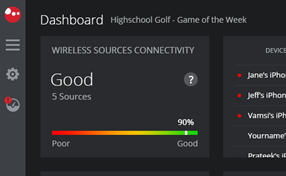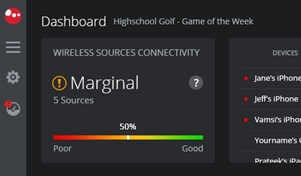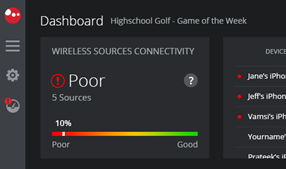SlingStudio Wi-Fi Hotspot Health is a term used to define the robustness of the wireless communication interface between the SlingStudio unit and mobile clients such as the Apple iPhone, the Apple iPod touch, the Apple iPad, Android smartphones, or HDMI cameras that are connected via the SlingStudio CameraLink device.
SlingStudio Console, when installed on an Apple iPad or a Mac computer and connected to a SlingStudio Wi-Fi hotspot, offers several tools that can be used to determine Wi-Fi health. The largest collection of such tools can be found in the Dashboard portion of SlingStudio Console.
As you read this article, refer to the Dashboard portion of Slingtudio Console to see what's being discussed here.
SlingStudio Wi-Fi Health
The SlingStudio Console Dashboard expresses Wi-Fi Health as a percentage: The greater the number, the more robust the audio/video wireless communication channel is (that is, the less chance of A/V signal loss).
SlingStudio Wi-Fi Health significance (green, yellow, red)
SlingStudio Wi-Fi Health is expressed using three levels:
| Level | Status | Possible result |
| Good | SlingStudio Wi-Fi Health at least 66% | No issues are expected with A/V streaming. |
| Marginal | SlingStudio Wi-Fi Health between 40% and 66% | Possible A/V streaming loss with very little extra capacity to make up for changes in conditions. |
| Poor | SlingStudio Wi-Fi Health less than 40% | Likely A/V streaming loss. |
Symptoms of poor SlingStudio Wi-Fi Health can vary. At worst, there might be a complete loss of the A/V feed. Lesser symptoms might include video breakup, low-quality images, video freezing, or audio loss.
Factors that can contribute to reduced SlingStudio Wi-Fi Health
SlingStudio Wi-Fi Health is can be affected by the following:
Improving SlingStudio Wi-Fi Health
There are several things that you can do to improve SlingStudio Wi-Fi Health:
More things that you can do
If you notice in the Dashboard (or elsewhere) that SlingStudio Wi-Fi Health is becoming marginal or poor, try to limit the number of remote video sources that are streaming, and/or try moving the video sources closer to the SlingStudio unit. Streaming video devices can work better if they're not competing for network bandwidth. If it's not possible to reduce the number of streaming video sources, or their distance to the SlingStudio unit, then try reducing the compression bandwidth or bit rate that the streaming video sources are using.
Here are some examples that can help you to identify settings that might work best for you based on the parameter(s) that you consider the most important:
These examples should render Wi-Fi Health that can be considered good, assuming little or no nearby router or device interference.
Priority: Number of cameras
Expected baseline set up (performance can vary better or worse)
4 cameras: 4 iPhones at 20 feet at 20 Mb/sec bit rate
3 cameras: 3 iPhones at 30 feet at 20 Mb/sec bit rate
2 cameras: 2 iPhones at 200 feet at 10 Mb/sec bit rate
1 camera: 1 iPhone at 200 feet at 20 Mb/sec bit rate
Priority: Bit rate setting
Expected baseline set up (performance can vary better or worse)
20 Mb/sec: 4 iPhones at 20 feet or 1 iPhone at 200 feet or 1 iPhone at 100 feet and 2 iPhones at 10 feet
16 Mb/sec: 4 iPhones at 30 feet
10 Mb/sec: 2 iPhones at 200 feet
4 Mb/sec: 4 iPhones at 150 feet
Priority: Distance
Expected baseline set up (performance can vary better or worse)
300 feet: 1 iPhone at <3 Mb/sec bit rate
200 feet: 2 iPhones at 10 Mb/sec or 1 iPhone at 20 Mb/sec bit rate
150 feet: 4 iPhones at 4 Mb/sec bit rate
100 feet: 2 iPhones at 10Mb/sec bit rate and 1 iPhone at 10 feet
60 feet: 3 iPhones at 10 Mb/sec bit rate and 1 iPhone at 10 feet
30 feet: 3 iPhones at 20 Mb/sec bit rate and 1 iPhone at 10 feet or 3 iPhones at 10 feet at 20 Mb/sec bit rate
20 feet: 4 iPhones at 20 Mb/sec bit rate
Notes:
Summary of Optimizing Wireless Setup
What you can do if your production is having audio/video quality problems
You also need to think about conserving network bandwidth if you have connected your SlingStudio unit to a Wi-Fi network so you can broadcast video to YouTube or Facebook. If you've done that, do not use the iPad that's running SlingStudio Console to check email or view web pages. Doing that consumes the network bandwidth that's needed for quality streaming.
Using the SlingStudio Console Dashboard to determine Wi-Fi Health
Here's some more detail about SlingStudio Console and the tools that it offers to help you determine (and improve) SlingStudio Wi-Fi Health.
First, access the SlingStudio Console Dashboard. Here's how:
SlingStudio for iPad:
SlingStudio for Mac:
The following three examples show what the Dashboard indicator looks like, with various states of Wi-Fi Health:



If you go further to check the hotspot, the information that you see:
